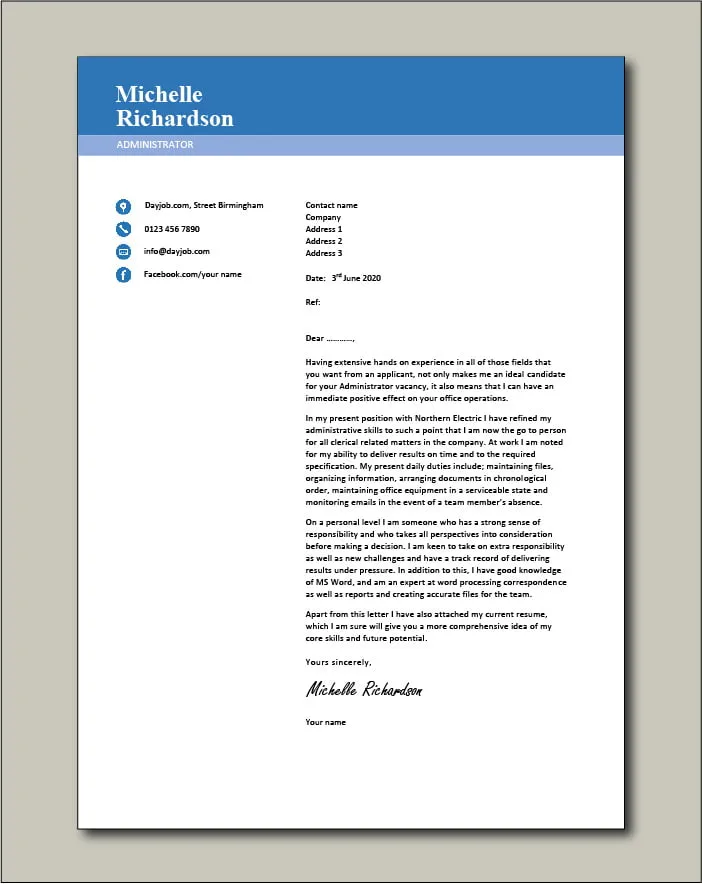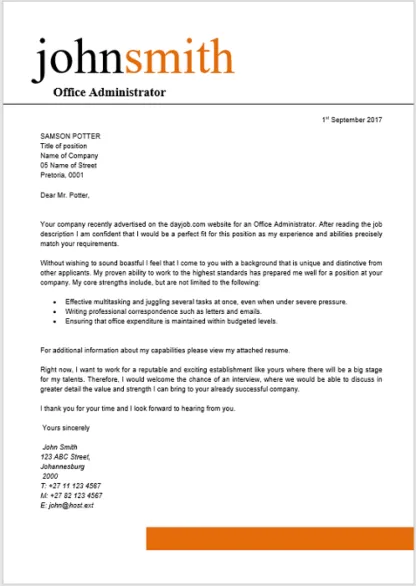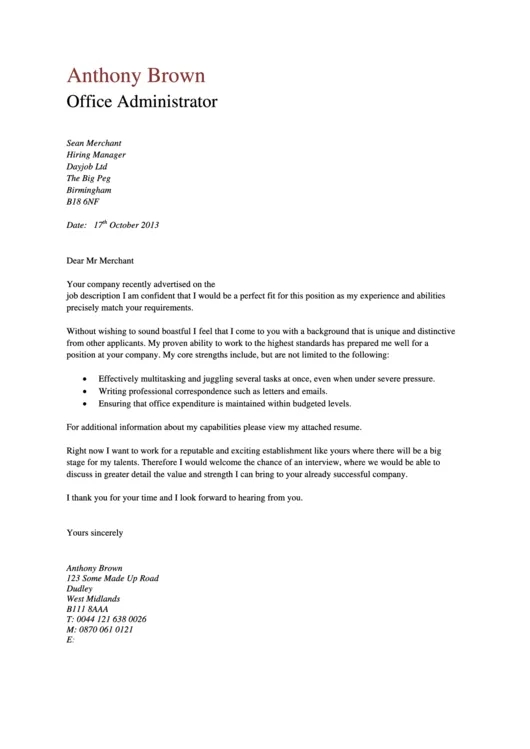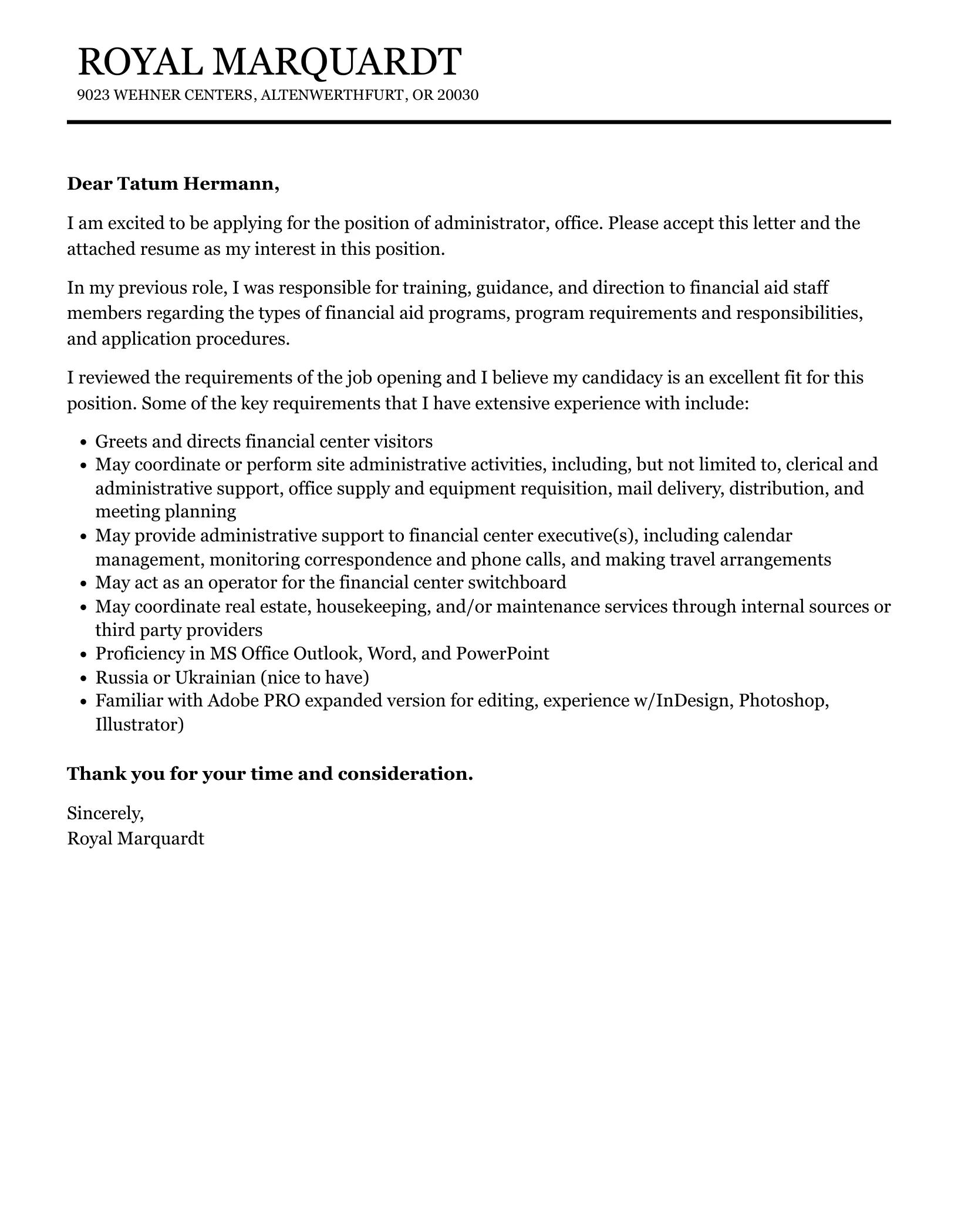Top 5 Office Administrator Cover Letter Examples
A well-crafted cover letter is your first introduction to a potential employer, serving as a crucial tool in your job application. For an office administrator position, this document provides an opportunity to showcase your organizational skills, attention to detail, and ability to contribute to a smooth-running office environment. This article presents five examples of effective office administrator cover letters, offering insights and strategies to help you create a compelling application. We’ll break down key components, highlighting how to tailor your letter to specific job requirements and demonstrate your value to prospective employers. Consider these examples as a springboard, guiding you to construct a cover letter that stands out and increases your chances of landing an interview.
Example 1 Tailoring Your Cover Letter
This example focuses on personalization. It underscores the importance of aligning your skills and experience with the specific needs of the company. The cover letter directly references the job description, highlighting how your qualifications meet the listed requirements. It opens by expressing genuine interest in the company and the specific role, referencing something that attracted you to the organization. The letter demonstrates a clear understanding of the company’s mission or values and provides examples of how your past experiences directly align with what they’re looking for. This level of personalization shows that you have taken the time to research the company and tailor your application to their specific needs. This approach helps create a strong initial impression.
Key Skills to Highlight

Within this tailored example, you’d emphasize the key skills that the company specifically seeks. For instance, if the job description emphasizes proficiency in Microsoft Office Suite, the cover letter must explicitly mention this, possibly providing examples of how you’ve used these skills in prior roles. If the role requires experience with specific software, such as CRM systems or accounting software, make sure these are clearly stated. Furthermore, it’s critical to include soft skills. These may include communication, organization, time management, and problem-solving abilities. Each mentioned skill should be supported by a brief example. For instance, if you mention ’exceptional organizational skills,’ provide an example of how you’ve managed a complex project or successfully handled multiple tasks simultaneously, ensuring all deadlines were met. Highlighting these skills ensures your relevance to the role.
Example 2 Showcasing Your Experience
This example centers on detailing your professional history. It begins with a concise summary of your work experience, mentioning previous employers and the roles you held. It then delves deeper, using bullet points or short paragraphs to describe your main responsibilities in these roles. Focus on tasks relevant to the office administrator position, such as managing schedules, handling correspondence, and coordinating meetings. This approach effectively showcases your background and provides a clear understanding of your professional trajectory. The key here is to demonstrate a consistent progression in your career, highlighting the increasing responsibilities and the skills acquired over time. Furthermore, using action verbs such as ‘managed,’ ‘coordinated,’ and ‘implemented’ in your descriptions will provide an active and dynamic tone.
Quantifying Achievements
In this example, it is crucial to move beyond describing your responsibilities and provide measurable results. Use numbers to quantify your accomplishments to make a more impactful statement. Did you improve office efficiency? Mention the percentage. Did you reduce costs? State the savings. For example, instead of writing “managed office supplies,” you could write “Reduced office supply costs by 15% through strategic vendor negotiations.” Such specific figures allow the employer to directly evaluate the value you can provide to their organization. These measurable outcomes clearly indicate the impact of your contributions, giving a more persuasive case for your capabilities. This also reflects your understanding of business goals and your capability to contribute to them. This approach helps you stand out from other candidates.
Example 3 Addressing the Company’s Needs

This type of cover letter is designed to align your skills with the specific requirements and challenges of the potential employer. First, research the company to find out more about their recent projects, goals, and any difficulties they might be facing. Then, carefully analyze the job description to understand the key responsibilities and required skills. Next, in your cover letter, show that you understand the company’s needs by directly addressing these in your qualifications and accomplishments. Give an example of how your experience can help them overcome certain issues or improve their current operations. Highlight your problem-solving skills by referencing scenarios where you’ve addressed similar challenges in previous roles. This shows you’re not only qualified but also ready to contribute to their success from day one. This will establish you as a proactive and thoughtful candidate.
Researching the Company Culture
Before writing this type of cover letter, conduct thorough research on the company’s culture. Visit their website, read their ‘About Us’ section, and check out their social media profiles to get a sense of their values and work environment. Learn about their mission, vision, and values to better understand what they prioritize. Also, look for employee reviews on sites such as Glassdoor, which can provide insights into the company culture. By using the research findings to demonstrate how well you will fit in with the company’s values and approach to work, you can better show that you are a good fit for their culture. This approach makes your application more personalized, highlighting that you have a genuine interest in joining the organization.
Example 4 Highlighting Soft Skills
This example focuses on showcasing your soft skills, which are critical for office administrator roles. Begin by identifying the essential soft skills for the position, like communication, teamwork, and problem-solving abilities. To highlight these, the letter needs to give concrete examples. Instead of stating that you are a good communicator, you could share an example, such as “Successfully managed communication between departments, leading to a 20% improvement in project completion times.” Emphasize your teamwork skills by referencing collaborations in previous roles. For problem-solving skills, provide instances where you have taken the initiative to resolve issues or streamline office processes. Highlighting such traits makes you more appealing to the employer. This approach reflects that you are well-rounded and can navigate the social and practical aspects of the workplace. These soft skills are essential to your success.
Communication and Interpersonal Skills

Given the importance of communication skills for office administrators, provide specific examples of how you have used these. For instance, explain how you handled various stakeholders, like clients or senior management. State examples of how you have effectively communicated important information in writing (emails, memos) and verbally (meetings, phone calls). Illustrate instances of successfully resolving conflicts or mediating issues among team members. Highlighting such situations and outcomes shows your ability to manage relationships effectively, ensuring a smooth and positive work environment. Your approach should convey clarity, diplomacy, and active listening, which are essential for building trust and maintaining strong working relationships. Such interpersonal abilities are highly valued in office administration.
Example 5 Emphasizing Your Enthusiasm
This cover letter demonstrates your excitement for the role and the company. Express genuine interest in the position and share why you are attracted to the company. Highlight aspects of their mission or values that resonate with you, showing you’re not just looking for a job but are enthusiastic about contributing to their success. When expressing enthusiasm, be specific. Instead of a generic statement, explain what makes you excited about the opportunity. This could be a particular project, the company’s work culture, or their recent achievements. Mention how your career goals align with the company’s objectives and the role’s responsibilities. By demonstrating sincere interest, you make your cover letter more compelling and stand out from the crowd.
Proofreading and Formatting Tips
Ensure your cover letter is flawless. Always proofread carefully for any grammatical errors, spelling mistakes, or typos. Even small mistakes may reflect negatively on your attention to detail. Use a professional and easy-to-read font, like Arial or Times New Roman, and keep the font size between 10 and 12 points. Ensure that the letter is well-structured and easy to follow. Use clear paragraphs, and consider adding bullet points for important information. Maintain consistent formatting throughout the document. Proper formatting and proofreading show that you are detail-oriented and committed to presenting yourself in the best possible light. A well-presented cover letter enhances the impact of your application, increasing the chances of getting your foot in the door.
